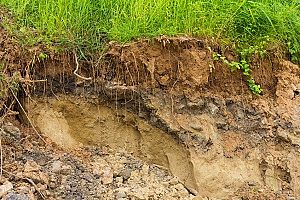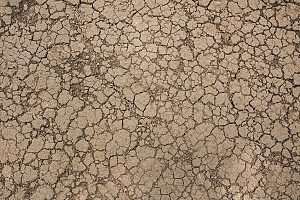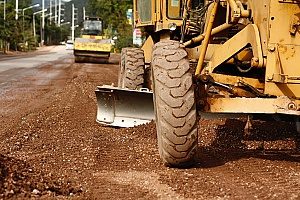 Soil erosion is described as the gradual and natural loss of topsoil. While soil erosion has a number of causes, the main culprit is water erosion. During rainfall, the impact of water hitting the ground causes the soil to loosen. During prolonged showers, water will pool on the ground and eventually flow on the surface of the land, a process known as surface water runoff.
Soil erosion is described as the gradual and natural loss of topsoil. While soil erosion has a number of causes, the main culprit is water erosion. During rainfall, the impact of water hitting the ground causes the soil to loosen. During prolonged showers, water will pool on the ground and eventually flow on the surface of the land, a process known as surface water runoff.
This runoff not only carries rainwater but also topsoil. While you cannot always prevent soil erosion, you can limit it. By using fill dirt in your residential grading construction project, you can help safeguard your landscape from water runoff.
Soil Erosion and Construction
An estimated one billion tons of topsoil is lost each year due to erosion, according to the U.S. Department of Agriculture. Not only does soil erosion wash away valuable topsoil which is essential for healthy plant and lawn growth, but the particles can also damage your property and even block waterways. Erosion essentially poses a threat to the environment by creating sediment runoff that pollutes nearby bodies of water, as well as storm drains. Water is not the only element to blame for soil erosion. Wind too can erode soil, making the ground more susceptible to water erosion.
Limiting Soil Erosion
Many homeowners rely on residential grading to help waterproof their homes and minimize problems such as basement flooding, foundation deterioration, and mold and mildew growth. However, construction can cause its own set of problems – primarily soil erosion from rain and water runoff. Limiting erosion during the construction process and after is crucial to preserve the structure of your project long-term. By taking the necessary steps to limit soil erosion, you can rest assured that the money and effort spent on the project is not wasted.
There are a number of actions that homeowners can take to control soil erosion. Some precautions can be taken during worksite preparation, such as adding logs or wattles to drains and other high-risk areas. It can also be beneficial to cover the bare earth during construction by spreading out straw over the worksite. Following construction, it can be highly advantageous to add vegetation to the area. Adding plant life to the soil can help reduce rapid soil movement and deter a loss of organic materials found in the soil.
 Some of the best ways to limit soil erosion following construction is to try and prevent erosion from occurring in the first place. Some practices that have been found useful in limiting soil erosion include:
Some of the best ways to limit soil erosion following construction is to try and prevent erosion from occurring in the first place. Some practices that have been found useful in limiting soil erosion include:
- Avoid performing construction during rainy or winter seasons
- Limit foot and vehicle traffic to minimize soil disturbance
- Revegetate bare soil soon after construction
- Save vegetation to minimize the amount of bare soil
- Avoid performing major construction near shorelines or streambanks
- Undergo regular inspections during construction
- Consider installing erosion control mats or blankets along ditches
- Have a plan in place to slow or divert the movement of water
How Fill Dirt Can Limit Erosion
If left unchecked, erosion can wash away topsoil causing a wide range of problems on your property. Fortunately, there are solutions that can help limit soil erosion. Fill dirt is one such remedy for limiting erosion by acting as a ground cover to keep topsoil in its place. With the help of a fill dirt contractor, you can add fill dirt to the construction site in areas that are prone to water runoff. The amount of fill dirt needed will depend on your unique landscaping and the extent of any existing slopes. Ideally, you should have a slope between 3 and 5 percent within 10 feet of the foundation.
In addition to using fill dirt, you will also want to take advantage of vegetation to minimize soil erosion. Replanting vegetation that is better suited to the unique site conditions can help maintain a satisfactory level of topsoil while creating an aesthetically pleasing landscape. When you are choosing plants for your yard, opt for plants that will best adapt to the new conditions of the site in terms of sunlight, shade, and water requirements. The plants have to be able to root and spread to limit soil erosion.
 Once you have your fill dirt in place, there are a number of ways to enhance your landscaping and better control future bouts of soil erosion. The use of edging and retaining walls has been found useful in holding the soil in place in areas where slopes contribute to erosion. There are a wide range of edging materials that can be used to deter erosion within a landscape, such as bricks and stones. Stones, boulders, and riprap can also be used effectively on low to moderate grade slopes on your property to help control soil erosion and stormwater runoff.
Once you have your fill dirt in place, there are a number of ways to enhance your landscaping and better control future bouts of soil erosion. The use of edging and retaining walls has been found useful in holding the soil in place in areas where slopes contribute to erosion. There are a wide range of edging materials that can be used to deter erosion within a landscape, such as bricks and stones. Stones, boulders, and riprap can also be used effectively on low to moderate grade slopes on your property to help control soil erosion and stormwater runoff.
When searching for ways to control soil erosion, you will likely come across the use of soil erosion fiber rolls and blankets. Both options help slow down the flow of surface water to curb erosion on slopes following construction. You can find these common erosion protection agents made of various synthetic materials, such as polypropylene. Some are also made from natural materials, such as jute, straw, or coconut fiber. Other types of erosion control agents on the market are constructed from materials such as silt fences, logs, or hale bales.
Contact a Fill Dirt Contractor
Proper residential grading is crucial to help maintain your home’s value and overall appearance. The construction process involves adjusting the slope of the land around your home to force water to pull away from your foundation rather than towards your home. While residential grading can have a wide range of benefits, it can also negatively affect the soil around your home.
Soil erosion can directly impact the structure of your project while also removing a healthy layer of soil needed for thriving crops and plant life. Limit soil erosion with the use of fill dirt. For more information on soil erosion or to schedule a free dirt delivery for your next land grading project, contact a fill dirt contractor today.









































